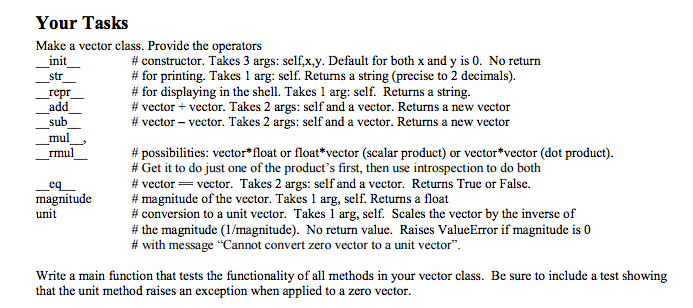in python please


Make a vector class. Provide the operators __init___ # constructor. Takes 3 args: self, x, y. Default for both x and y is 0. No return __str___ # for printing. Takes 1 arg: self. Returns a string (precise to 2 decimals). ___repr___ # for displaying in the shell. Takes 1 arg: self. Returns a string. ___add___ #vector + vector. Takes 2 args: self and a vector. Returns a new vector ___sub____ #vector - vector. Takes 2 args: self and a vector. Returns a new vector ___mul____, ___rmul___ # possibilities: vector*float or float*vector (scalar product) or vector*vector (dot product) #Get it to do just one of the product's first, then use introspection to do both __eq___ #vector = vector. Takes 2 args: self and a vector. Returns True or False. magnitude #magnitude of the vector. Takes 1 arg, self. Returns a float #conversion to a unit vector. Takes 1 arg, self. Scales the vector by the inverse of unit #the magnitude (1/magnitude). No return value. Raises ValueError if magnitude is 0 #with message "Cannot convert zero vector to a unit vector". Write a main function that tests the functionality of all methods in your vector class. Be sure to include a test showing that the unit method raises an exception when applied to a zero vector. Assignment Overview We are going to work with overloaded operators and making our own class. We are going to make a 2D vector class. Some Background So if you don't remember, here is a little background on two-dimensional vectors. A vector is basically an arrow that has a magnitude (a length) and a direction (an angle with respect to typically the x axis). It usually is represented as an x, y pair, where the origin of the vector is a 0, 0 and the head of the vector is at the listed pair. Here are some of the operations you can perform on a vector. vector addition. If V1 is (x, y) and V2 is (a, b), the V+W is (x+a, y+b), a vector vector multiplication by a scalar, if V1 is (x, y), the V*n is (x*n, y*n), a vector vector subtraction V-W is the same as V+(W*-1), a vector vector multiplication with another vector. There are two possibilities, dot product or cross product. We'll do dot product. If V=(x, y) and W=(a, b), then V*W = x*a + y*b, a scalar. Thus the dot product yields a scalar, not a vector vector magnitude. The magnitude based on the Pythagorean theorem for a V=(x, y) says that the magnitude is squareroot (x**2 + y**2). You might look at math.hypot for this Make a vector class. Provide the operators __init___ # constructor. Takes 3 args: self, x, y. Default for both x and y is 0. No return __str___ # for printing. Takes 1 arg: self. Returns a string (precise to 2 decimals). ___repr___ # for displaying in the shell. Takes 1 arg: self. Returns a string. ___add___ #vector + vector. Takes 2 args: self and a vector. Returns a new vector ___sub____ #vector - vector. Takes 2 args: self and a vector. Returns a new vector ___mul____, ___rmul___ # possibilities: vector*float or float*vector (scalar product) or vector*vector (dot product) #Get it to do just one of the product's first, then use introspection to do both __eq___ #vector = vector. Takes 2 args: self and a vector. Returns True or False. magnitude #magnitude of the vector. Takes 1 arg, self. Returns a float #conversion to a unit vector. Takes 1 arg, self. Scales the vector by the inverse of unit #the magnitude (1/magnitude). No return value. Raises ValueError if magnitude is 0 #with message "Cannot convert zero vector to a unit vector". Write a main function that tests the functionality of all methods in your vector class. Be sure to include a test showing that the unit method raises an exception when applied to a zero vector. Assignment Overview We are going to work with overloaded operators and making our own class. We are going to make a 2D vector class. Some Background So if you don't remember, here is a little background on two-dimensional vectors. A vector is basically an arrow that has a magnitude (a length) and a direction (an angle with respect to typically the x axis). It usually is represented as an x, y pair, where the origin of the vector is a 0, 0 and the head of the vector is at the listed pair. Here are some of the operations you can perform on a vector. vector addition. If V1 is (x, y) and V2 is (a, b), the V+W is (x+a, y+b), a vector vector multiplication by a scalar, if V1 is (x, y), the V*n is (x*n, y*n), a vector vector subtraction V-W is the same as V+(W*-1), a vector vector multiplication with another vector. There are two possibilities, dot product or cross product. We'll do dot product. If V=(x, y) and W=(a, b), then V*W = x*a + y*b, a scalar. Thus the dot product yields a scalar, not a vector vector magnitude. The magnitude based on the Pythagorean theorem for a V=(x, y) says that the magnitude is squareroot (x**2 + y**2). You might look at math.hypot for this








